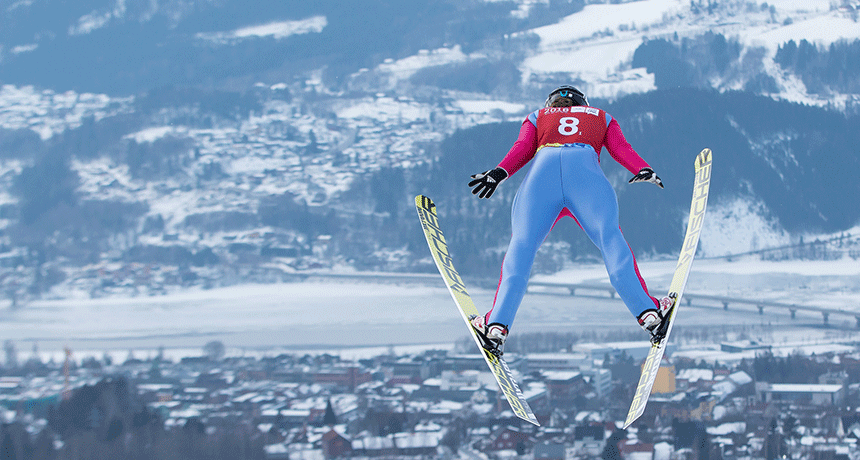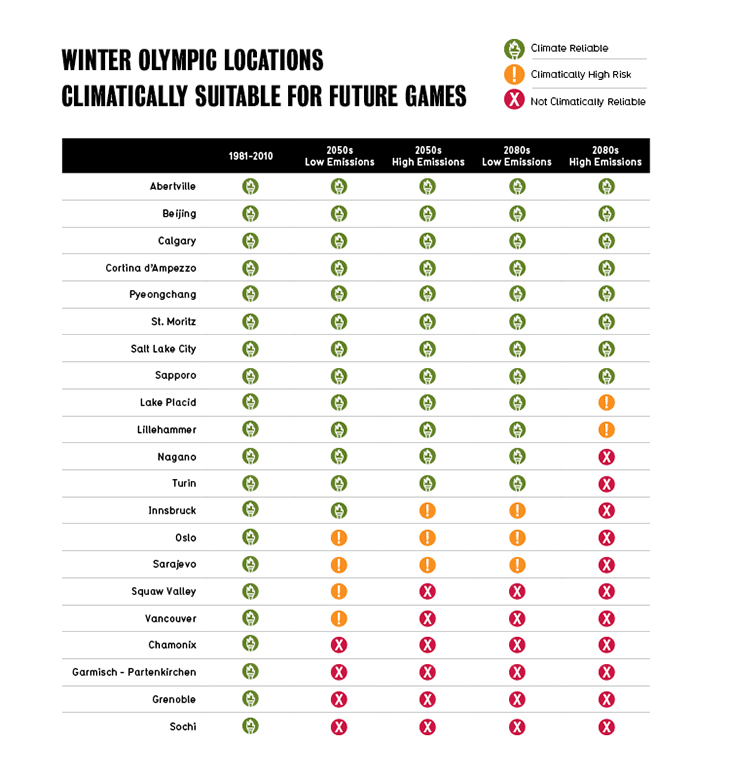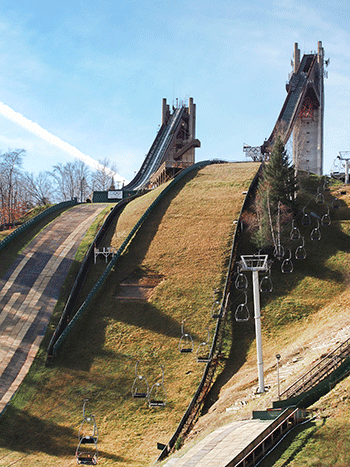Climate change threatens future Winter Olympics
Higher temps and reduced snow forecasted for former host cities

Ski jumping is one of many outdoor sports at the Winter Olympics. Rising temperatures, however, could limit how many cities would be cold enough to accommodate such events at future games.
Vegar Samestad Hansen/Wikimedia Commons (CC BY 2.0)
More than half of former host cities for the Winter Olympics will be literally too hot to handle such games by the end of this century. That’s the prediction of a study published this week forecasting temperatures and snow cover for the 21 host cities.
And it’s not just the Olympics that are at risk. “The world of winter sports is changing as the global climate continues to warm,” says Daniel Scott. He is a climate-change researcher in Canada who works at the University of Waterloo in Ontario. He led a team of researchers who used math to predict how winter conditions will have changed by February 2050 and 2080. Why focus on February? That’s the month in which the Olympic winter games are typically played.
“Winter sports and the cultural activities that go with them may go by the wayside for people living in some regions,” he says.
And ski tourism is no small issue. Across the globe, it brings in billions of dollars’ worth of funds to communities large and small. But the biggest ski-tourism bonanzas may be those associated with the Olympics.
Winter Olympics are usually held every four years. Scott and his team team considered projections for future weather in 21 cities. These included the 19 cities that already have hosted Winter Olympics. The team also looked at two additional cities. The first is this year’s host: PyeongChang, South Korea. The second is Beijing, China. That’s where the 2022 Winter Olympics will take place.
The good news: Both PyeongChang and Beijing should be cold enough in February to be available for winter Olympic games through 2080.
It was 2014 when Scott’s team first reported finding that “it would be difficult to imagine recent host cities/regions successfully delivering the diverse [Olympic] Games programme exclusively on natural ice and snow.” They’d need to supplement Mother Nature’s white fluff with artificially made snow. That can be done. But it’s costly and doesn’t always supply the quantity and quality of snow that gold-medal-class athletes expect.
Their new assessment appeared February 6 in the journal Current Issues in Tourism.
The warming effect of greenhouse gases
Studies have shown that releases of greenhouse gases in recent years have played a big role helping to warm the planet. So Scott’s group analyzed two scenarios. In one, they assumed releases of those gases would continue to grow as they have been in recent years. Then, they calculated how February temperatures across the globe would change by 2050.
They would likely rise by 2.6 degrees Celsius (4.7 degrees Fahrenheit), they now report. (That’s compared to before the Industrial Revolution, when releases of greenhouse gases first started to climb.) By 2080, those temps would likely rise by 4.3 degrees C (7.7 degrees F).
The team also looked at what would happen if governments around the world cut greenhouse-gas releases. Then temperatures might rise by only 1.6 degrees C (2.9 degrees F) by 2050. After that, they could hold steady at 1.6 degrees C above the past, long-term average — even as late as 2080.
However, notes Scott, whether countries could achieve that is “a big ‘if.’” Indeed, he says, keeping releases of those gases from climbing is “an ambitious target.” Even if nations pledged to cut releases of these, they still might not hit their goal.
Under the make-no-changes scenario, nine of the host sites will be too warm for the games by 2050. Those include Sochi, Russia, and the alpine cities of Grenoble in France and Garmisch-Partenkirchen in Germany. The number increases to 13 cities by 2080. Cutting down current rates of greenhouse-gas releases would help. But even then, eight former Winter Olympics sites still would be unable to host the games by 2050. Nine wouldn’t qualify by 2080.
Story continues below image.

Predicting the future
To come up with both sets of these predictions, Scott’s team started by looking at historic winter conditions. The researchers found the average February daytime temperature of the 19 sites of the former winter games has increased steadily. Average temps rose from 0.4 °C (33 °F) at the sites of games held in the 1920s through 1950s, to 3.1 °C (38 °F) in games held during from the 1960s through 1990s. For games held since 2000, February averages are now about 7.8°C (46 °F).
The researchers then used computer models to predict conditions in the future. A computer model is a program that runs on a computer and calculates what is likely to occur. (One example may be estimates of temperatures likely to develop in the real world.) The researchers’ model is based on those used by hundreds of scientists from the Intergovernmental Panel on Climate Change, or IPCC.
Their model predicted that by 2050, the average February temperatures in past Winter Olympic host sites will likely warm an extra 1.9 to 2.1 degrees C (3.4 to 3.8 degrees F). By 2080, temperatures will rise by 2.7 to 4.4 degrees C (4.9 to 7.9 degrees F) over what they are today.
Scott and his team also looked at the effect of these temperatures on snow. Many winter sports need a base of at least 30 centimeters (about a foot) of snow. The researchers assumed that a city could no longer handle outdoor games if it would have less than this amount.
The researchers made predictions for both natural snow and that made artificially. (Artificial snow is made by spraying fine droplets of water into the air through hoses. If the air is cold enough — at least – 5 °C [23 °F] — water freezes right away and falls as snow.) Even if daytime temperatures are above freezing, people can make snow if nighttime temperatures are below that minimum temperature.
Daytime warmth is another important factor. It can affect the quality of snow. Warming can make ski courses too fast or too slow. Skiing at an Olympic level already can be a dangerous activity. Poor snow quality can up the risk of accidents.
Beyond the Olympics
In the paper released last week, Scott’s team also considered the effects of climate change on the Winter Paralympics. These are similar to the Olympics, but the competing athletes all have some type of disability. The Paralympics are held in March, a month after the Winter Olympics. Temperatures and snow cover in March can be even less winter-like, Scott points out.

If there is no drop in greenhouse-gas emissions, 13 cities would no longer be able to handle the Winter Paralympics by 2050, the study finds. By 2080, that number would climb to 17. Yet even with cuts in releases of those gases, 11 cities still fall off the list of possible hosts for the Winter Paralympics by 2050 and 2080.
Scott would therefore like to see organizers to combine the two games in February, when colder temperatures would be more reliable.
Other research suggests the effect of rising temperatures won’t be limited to Olympic athletes. A study of 247 ski hills in the United States projected that nearly all will see shorter ski seasons. The length of the average ski season would likely fall by more than half by 2050 — and by 80 percent within the 30 years after that.
Cameron Wobus is part of the team that published these calculations in Global Environmental Change last July. Wobus is a scientist who uses math to understand environmental changes and their effects on people. He works for a science consulting company called Abt Associates in Boulder, Colo.
Sites that would see the shortest ski seasons are in the U.S. Northeast, he found. “That’s mostly because the elevation [there] is much lower than in the West,” he says. “When you are up high, at 12,000 feet [3,700 meters], it’s much cooler in the winter.”
If Winter Olympics organizers want reliable cold temperatures, he says, they will have to hold the games at high elevations. One catch: Few cities could meet this requirement.







